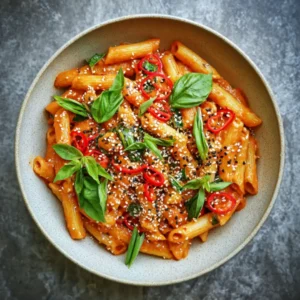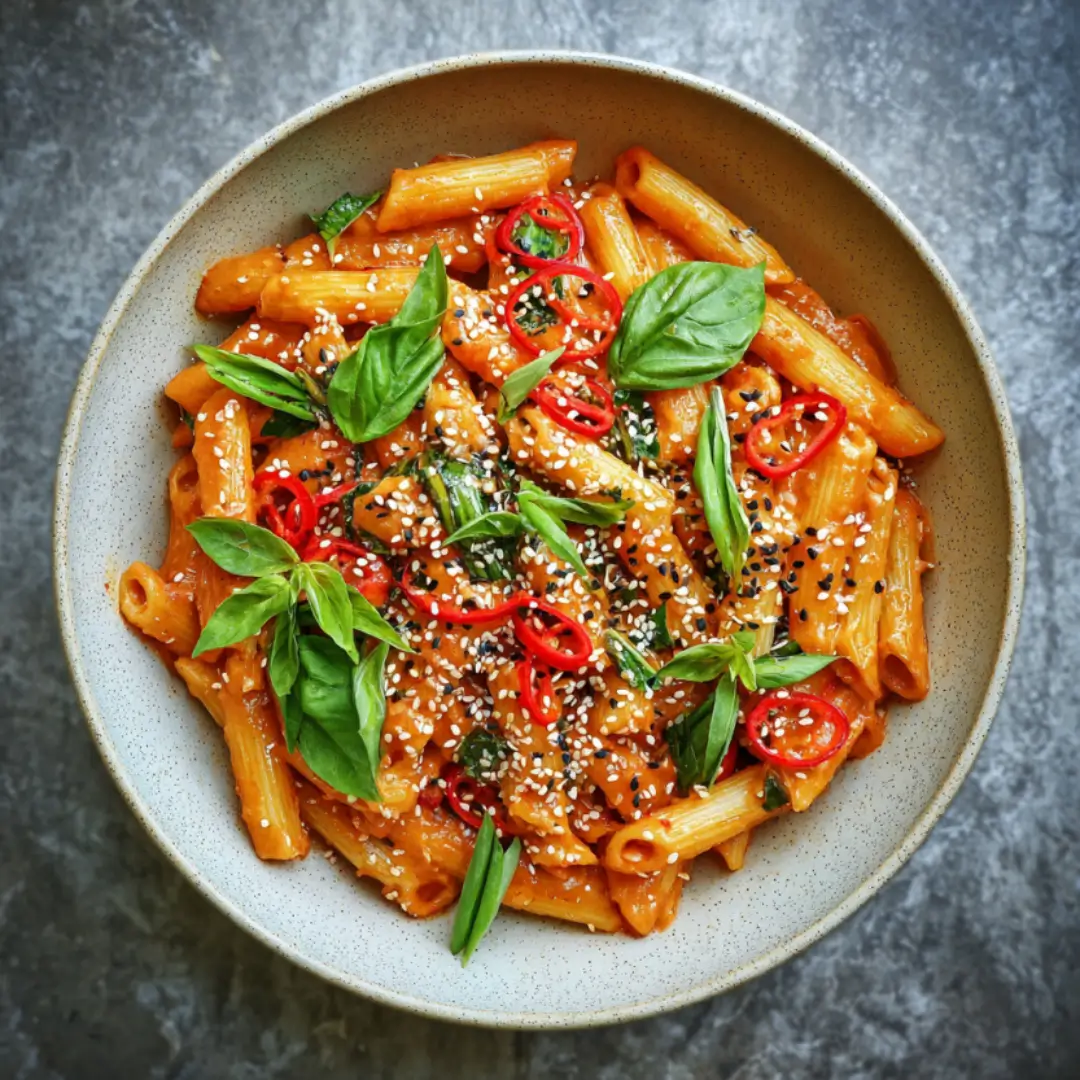Gochujang pasta is a quick and easy meal you can make in about 20 minutes. It combines spicy and savory Korean chili paste with creamy sauce and pasta for a tasty dish. If you want something different and full of flavor, this pasta is a great choice.
Why We Love This Gochujang Pasta Recipe
You’ll find many reasons to keep this recipe in your regular rotation. First, it’s incredibly fast to make — ready in about 20 minutes, which is perfect for busy weeknights. The blend of gochujang paste and cream gives the pasta a unique flavor profile that’s both spicy and rich without being overwhelming. It’s easy to customize with your choice of pasta and heat level, so it suits your taste perfectly. Plus, the toasted sesame seeds and fresh basil garnish add texture and freshness, turning a simple pasta into an exciting, restaurant-worthy dish.
Ingredients You’ll Need for Gochujang Pasta
Here’s what you’ll gather to make this delicious Korean-inspired pasta:
- 4 tablespoons gochujang (Korean chili paste)
- 1 tablespoon toasted sesame oil
- 2 tablespoons soy sauce
- 2 tablespoons mirin (a sweet rice wine)
- 1 tablespoon honey (optional, depending on how sweet you want it)
- 1 to 2 tablespoons gochugaru (Korean chili flakes)
- 500 grams (about 17 ounces) dried pasta of your choice
- 2 tablespoons rapeseed or canola oil
- 4 spring onions (scallions), finely chopped
- 5 garlic cloves, finely chopped
- 1 inch piece of ginger, finely chopped
- 3 finger chillies, thinly sliced
- 200 grams chopped tomatoes (fresh or canned)
- 125 milliliters double cream or half-and-half
- 3 tablespoons toasted sesame seeds
- Salt and pepper to taste
- Fresh basil leaves and extra sesame seeds for garnish
How to Make Gochujang Pasta
Start by making the gochujang paste sauce. In a mixing bowl, whisk together gochujang, toasted sesame oil, soy sauce, mirin, gochugaru, and honey if you want some extra sweetness. Taste the sauce and adjust the honey if you prefer a sweeter touch. Set this aside while you prepare the rest of the dish.
Next, cook your pasta according to the package instructions. Any pasta shape works well here, so use your favorite. Once cooked, drain the pasta in a colander and immediately toss it with about a teaspoon of toasted sesame oil. This prevents the pasta from sticking together and adds a subtle nutty flavor.
While the pasta cooks, heat the rapeseed oil in a wok or a large pan over medium-high heat. Add the finely chopped garlic, ginger, spring onions, and sliced chillies. Stir-fry these aromatics for about one minute until they soften and release their fragrance.
Add the chopped tomatoes to the pan along with your prepared gochujang sauce. Bring the mixture to a gentle simmer so all the flavors can meld together.
Now, pour in the cream and add the toasted sesame seeds. The amount of cream can be adjusted depending on how rich and creamy you want your sauce. A good starting point is about 125 ml, but you can reduce or increase this to suit your taste.
Once the sauce is simmering, add the cooked pasta to the pan. Stir everything well so the pasta is fully coated in the flavorful sauce. Warm it through over low heat and then season with salt and pepper to taste.
Finally, divide the pasta between bowls and garnish with fresh basil leaves and a sprinkle of extra toasted sesame seeds. The basil adds a fresh, herbaceous note that balances the heat and creaminess perfectly.
How to Serve Gochujang Pasta
Serving this pasta is simple and satisfying. Plate it in shallow bowls to show off the creamy sauce coating each strand. Fresh basil leaves on top add a pop of green that makes the dish visually appealing. You can pair it with a light side salad or steamed vegetables for a well-rounded meal. A crisp cucumber salad or simple sautéed greens work especially well to cool down the spicy notes from the gochujang.
This pasta also holds up well as leftovers, so it can be great for meal prepping. Reheat gently on the stove or in the microwave, adding a splash of water or cream if needed to loosen the sauce.
Expert Tips for Making Perfect Gochujang Pasta
- Adjust the spice: Gochujang and gochugaru vary in heat. Start with less if you’re sensitive to spice and add more as you go.
- Use good quality sesame oil: It has a strong flavor, so a little goes a long way in enhancing your sauce.
- Don’t overcook the pasta: Cook it just until al dente for the best texture. Toss with oil right after draining to avoid clumping.
- Fresh aromatics matter: Using fresh garlic, ginger, and spring onions really elevates the dish with vibrant flavors.
- Cream choice: Double cream makes it richer, but half-and-half is a lighter option that still adds creaminess.
- Toast your sesame seeds: Lightly toasting them before adding enhances their nutty flavor and adds crunch.
- Customize your heat and sweetness: Balance the sauce by tasting as you go, adding honey or extra chili to suit your preference.
How to Store Gochujang Pasta
If you have leftovers, store them in an airtight container in the refrigerator for up to 3 days. When reheating, add a splash of cream or water to help loosen the sauce and prevent it from drying out. Pasta tends to absorb sauce overnight, so stirring while warming helps keep the texture smooth. Avoid freezing as the cream-based sauce may separate and affect the dish’s texture.
Variation Ideas for Gochujang Pasta
There are many ways to tweak this recipe to fit your mood or available ingredients. You can swap the cream for coconut milk for a dairy-free, slightly tropical twist. Try adding cooked chicken, tofu, or shrimp to turn it into a protein-packed meal. For a vegetable boost, toss in sautéed mushrooms, spinach, or bell peppers. You might also experiment with different pasta shapes or whole grain pasta for added fiber and texture.
If you prefer less heat, reduce the amount of gochugaru or chillies and add a little extra honey to balance the flavor. Alternatively, for an extra kick, include a splash of hot sauce or chili oil.
Frequently Asked Questions About Gochujang Pasta
What does gochujang taste like?
Gochujang is a Korean chili paste that is spicy, slightly sweet, and savory with a rich umami flavor. It adds depth and heat to dishes without being overwhelmingly hot.
Can I use other pasta types?
Yes, feel free to use any dried pasta like spaghetti, penne, fusilli, or even gluten-free options. The sauce pairs well with most shapes.
Is this recipe very spicy?
The heat level depends on how much gochujang and gochugaru you add. You can adjust these ingredients to suit your spice preference.
Can I make this recipe vegan?
Yes, substitute the cream with coconut milk or a plant-based cream alternative and ensure your pasta is egg-free.
How should I store leftovers?
Keep any leftovers refrigerated in a sealed container and consume within 3 days. Reheat gently with a splash of liquid to keep the sauce smooth.
Does the pasta stick together when stored?
To avoid sticking, toss cooked pasta with a little sesame oil right after draining. If storing for a longer time, rinse under cold water before tossing with oil.

Gochujang Pasta
Ingredients
- 4 tablespoons gochujang (Korean chili paste)
- 1 tablespoon toasted sesame oil
- 2 tablespoons soy sauce
- 2 tablespoons mirin (a sweet rice wine)
- 1 tablespoon honey (optional)
- 1 to 2 tablespoons gochugaru (Korean chili flakes)
- 500 grams dried pasta (about 17 ounces)
- 2 tablespoons rapeseed or canola oil
- 4 whole spring onions (scallions, finely chopped)
- 5 cloves garlic (finely chopped)
- 1 inch ginger (finely chopped)
- 200 grams chopped tomatoes (fresh or canned)
- 125 milliliters double cream or half-and-half
- 3 tablespoons toasted sesame seeds
- Salt (to taste)
- Pepper (to taste)
Instructions
- In a mixing bowl, whisk together gochujang, toasted sesame oil, soy sauce, mirin, gochugaru, and honey (if using). Set aside.
- Cook pasta according to package instructions, then drain and toss with a teaspoon of toasted sesame oil.
- Heat rapeseed oil in a wok or large pan over medium-high heat. Add garlic, ginger, spring onions, and sliced chillies. Stir-fry for about one minute until fragrant.
- Add chopped tomatoes and gochujang sauce to the pan. Bring to a gentle simmer.
- Pour in cream and add toasted sesame seeds. Stir until combined and simmer.
- Add cooked pasta, stirring to coat in sauce. Season with salt and pepper to taste.
- Serve garnished with fresh basil leaves and extra sesame seeds.
Send me this recipe!
Just enter your email below and get it sent straight to your inbox!



